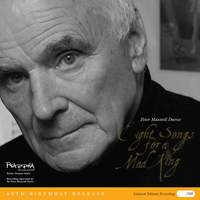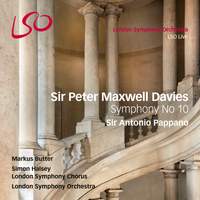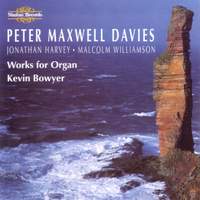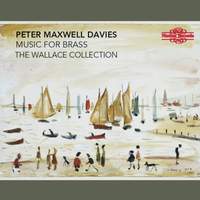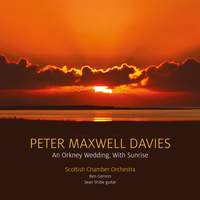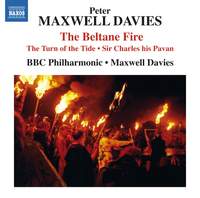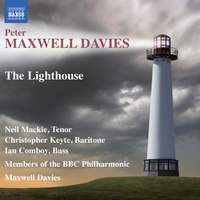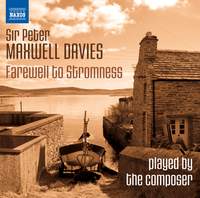Favourites,
Peter Maxwell Davies: A postcard from Hoy, and a farewell to Stromness
Last month I spent ten days on holiday in the Orkney Islands, just off the north coast of the Scottish mainland. Among other things, I was keen to visit the former house of the late Peter Maxwell Davies (1934-2016), who I knew had lived on Hoy - the second-biggest of the archipelago - for much of his later life, drawing inspiration from the remote and unspoilt landscapes in many of his works. The annual St Magnus Festival, which he founded in 1977, continues to this day in the capital, Kirkwall.

Little did I know that this would turn out to be quite an expedition. Hoy is the only one of the otherwise largely flat islands to be significantly mountainous, and Maxwell Davies’s erstwhile home lies in a steep-sided bay on its less accessible shore. Getting there involved taking a ferry from the Orkney mainland, driving for half an hour over the hills, and then some hiking over the moorland (including consulting Google Maps’ satellite mode to spot paths too small to show on the map proper…)
The house’s name, “Bunnertoon”, means “above the town” in the local dialect; the “town” in question is Rackwick, with a permanent population of at most a few dozen. About a mile out beyond the last house on the village’s outskirts, after the last vehicle track has petered out, the cottage that Maxwell Davies once called home comes into view, reached only on foot and barely even visible from the village in the bay below. It really brings home how much he must have valued privacy and isolation - though one does wonder if, in the long dark nights of winter, even the most committed of hermits might have entertained some second thoughts…
As it happens, 8th September would have been Maxwell Davies’s 89th birthday, so here is a small selection of recordings of his works - some with a direct connection to the Orkney Islands, and some not.
The Eight Songs from 1969 were one of Maxwell Davies’s breakthrough works - a deliberately iconoclastic, shocking composition that took one of the most venerated pieces in the classical canon (Handel’s Messiah) and parodied it as a means of exploring King George III’s famous mental instability. Maxwell Davies takes the legacy of Schoenberg’s Pierrot Lunaire and builds on it in new directions.
Available Formats: Vinyl Record, MP3, FLAC
Maxwell Davies: Symphony No. 10
Markus Butter (baritone), London Symphony Chorus, London Symphony Orchestra, Sir Antonio Pappano
Maxwell Davies’s last major composition, his tenth symphony dating from 2013, is inspired by the 17th-century Italian architect Francesco Borromini, including a sonnet dedicated to him. The texture is often rich and dark, with low wind and brass prominent in the instrumentation.
Available Formats: MP3, FLAC, Hi-Res FLAC
En route to Stromness, the ferry from the Scottish mainland sails up past the coast of Hoy (indeed past Rackwick Bay itself), with excellent views of the imposing sea stack known as the Old Man of Hoy, as seen on the front cover of this album of organ works. Maxwell Davies’s penchant for adapting elements from plainsong is particularly in evidence in the fourteen-minute Fantasia on ‘O Magnum Mysterium’.
Available Formats: CD, MP3, FLAC
Maxwell Davies: Litany for a ruined chapel between sheep and shore & other works for brass
John Wallace & John Miller (trumpets), Paul Gardham (horn), Simon Gunton (trombone) & Robin Haggart (tuba), The Wallace Collection
Sea Eagle is well known to horn players (if playable by few), but Litany for a ruined chapel between sheep and shore was new to me. The title perfectly encapsulates some of the smaller and quieter islands such as Egilsay and Papa Westray, with small grey kirks in various states of disrepair often only a stone’s throw from the sea, and surrounded on all sides by grazing sheep.
Available Formats: CD, MP3, FLAC
Maxwell Davies: Hill Runes, An Orkney Wedding & other works
Sean Shibe (guitar), Scottish Chamber Orchestra, Ben Gernon
Designated a UNESCO World Heritage Site in 1999, the Heart of Neolithic Orkney complex arguably eclipses England’s Stonehenge in everything except geographical accessibility. Dotted around the islands’ low hills, too, are numerous tombs and cairns, several of which bear runic inscriptions - a deep and storied past evoked by the title of the work Hill Runes. An Orkney Wedding, with Sunrise is among Maxwell Davies’s most popular and approachable works.
Available Formats: MP3, FLAC, Hi-Res FLAC
Maxwell Davies: The Beltane Fire, The Turn of the Tide etc.
BBC Philharmonic Orchestra, Manchester Cathedral Choir, Manchester Cathedral Voluntary Choir, Manchester Grammar School Boys' Choir, Peter Maxwell Davies
The legacy of Norse paganism is perhaps stronger in Shetland than in Orkney, but the latter islands certainly saw their own power-struggles between Christianising influences and indigenous traditions. The Beltane Fire dramatises this culture-clash, while The Turn of the Tide shows Maxwell Davies’s concern for the preservation and protection of the natural world (a running theme in much of his work).
Available Formats: CD, MP3, FLAC
Maxwell Davies: The Lighthouse
Neil Mackie (tenor), Christopher Keyte (baritone) & Ian Comboy (bass), Members of the BBC Philharmonic, Peter Maxwell Davies
Every coastline has its lighthouses, of course, and Orkney is no exception - with many a tragic shipwreck over the years, especially off the tidal islet of Birsay, whose bijou, crenellated lighthouse is now an automated installation. Maxwell Davies’s opera is set not in Orkney but in the Outer Hebrides, based on the real-life mystery (unsolved to this day) of three lighthouse-keepers’ disappearance in 1900.
Available Formats: CD, MP3, FLAC
By far, Maxwell Davies’s most popular and performed composition is the haunting Farewell to Stromness, written in 1980 to form part of the Yellow Cake Revue - his musical protest against the prospect of mining uranium in Orkney, which would have forced many islanders to leave for the mainland, seeing Stromness for the last time as the ferry pulled out of its harbour. Farewell to Stromness has been transcribed for numerous instruments and transformed into a vocal number by Ray Connolly. On this single, released as a tribute shortly after his death in March 2016, it is performed on the piano by the composer himself.
Available Formats: MP3, FLAC


